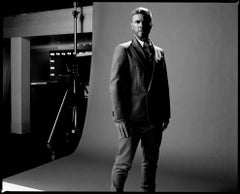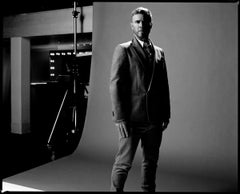Gary Barlow
2010s Modern Black and White Photography
Archival Pigment
2010s Modern Black and White Photography
Archival Pigment
2010s Modern Black and White Photography
Archival Pigment
2010s Modern Portrait Photography
Black and White, Archival Pigment
Kevin Westenberg for sale on 1stDibs
Kevin Westenberg is famed - for his creation of provocative and electrifying images of world-class musicians, artists and movie stars for over 25 years. His technique of lighting, color and composition has helped to produce his own unique visual style. Shortly after receiving an architecture degree, Westenberg moved to London where he’s been based since 1983. Westenberg is self-taught and learned his trade working for the UK inkies New Musical Express and Melody Maker mainly throughout the late 80s and 90s documenting amongst others all the UK ‘Britpop’ bands. The breakthrough came in 1993–94 with the release of Sting’s Ten Summoner’s Tales and Mary J Blige’s Share My World. These two album covers changed the perception of the work worldwide and thus began a run of 20 years of commissions and choice opportunities. For the last 25 years, his musical heritage includes portraits of Radiohead, Thom Yorke, Coldplay, White Stripes, Jane's Addiction, Sting, Bjork, Nirvana, Jeff Buckley, Luther Vandross, Nine Inch Nails, Stone Roses, The Pixies, Paul Weller, Rufus Wainwright, Michael Stipe, U2, Mary J. Blige, R.E.M., Black Sabbath, Massive Attack, BB King, The Rolling Stones, PJ Harvey, Marilyn Manson, Pete Doherty, Oasis, Soundgarden, Jake Bugg and Bon Jovi among many others. Also included are 100’s of albums, singles, magazine and book covers from around the world. He’s also been chosen as an official photographer for the LIVE 8 Hyde Park event in 2005 and for Led Zeppelin reunion concert at the 02 Arena, London. The work and interest also include a wide range of artists portraits beyond the music world. David Lynch, Paul Auster, The Coen Brothers, Rupert Friend, Sir Tom Stoppard, Orla Kiely, Vincent Cassel, Audrey Tautou, Billy Bob Thornton, Ethan Hawke, Alan Rickman, Daniel Bruhl, Sean Penn, Shirley Henderson, Aaron Eckhart, Robin Wright, Rhys Ifans, Frances McDormand, Jean-Luc Godard, Ray Winstone, Michel Gondry and Naomi Watts are amongst these portraits. Rolling Stone, Spin, Q, Time Out, Les Inrockuptibles, Vogue, Rockin On Japan, Esquire, New York Times Magazine, Telegraph and Observer Magazines, Interview and dozens of others around the world have commissioned him. In the last 15 years, he’s been a staff photographer at MOJO Magazine, producing many covers and features. Most recently photographing Sir Paul McCartney for the cover story of the November 2013 issue. Westenberg’s biggest honor to date arrived in 2012, when he had his first major global museum show. The location was the ‘Kobe Fashion Museum’, one of Japan’s largest museums. The whole museum was dedicated to Westenberg’s works for a 3 month period. Over 70 images were included in a wide range of sizes, styles and presentation. The catalog produced sold out during the exhibition’s run. The 20-year attendance record for the museum was also broken by the exhibition.
A Close Look at Modern Art
The first decades of the 20th century were a period of artistic upheaval, with modern art movements including Cubism, Surrealism, Futurism and Dadaism questioning centuries of traditional views of what art should be. Using abstraction, experimental forms and interdisciplinary techniques, painters, sculptors, photographers, printmakers and performance artists all pushed the boundaries of creative expression.
Major exhibitions, like the 1913 Armory Show in New York City — also known as the “International Exhibition of Modern Art,” in which works like the radically angular Nude Descending a Staircase by Marcel Duchamp caused a sensation — challenged the perspective of viewers and critics and heralded the arrival of modern art in the United States. But the movement’s revolutionary spirit took shape in the 19th century.
The Industrial Revolution, which ushered in new technology and cultural conditions across the world, transformed art from something mostly commissioned by the wealthy or the church to work that responded to personal experiences. The Impressionist style emerged in 1860s France with artists like Claude Monet, Paul Cézanne and Edgar Degas quickly painting works that captured moments of light and urban life. Around the same time in England, the Pre-Raphaelites, like Edward Burne-Jones and Dante Gabriel Rossetti, borrowed from late medieval and early Renaissance art to imbue their art with symbolism and modern ideas of beauty.
Emerging from this disruption of the artistic status quo, modern art went further in rejecting conventions and embracing innovation. The bold legacy of leading modern artists Georges Braque, Pablo Picasso, Frida Kahlo, Salvador Dalí, Henri Matisse, Joan Miró, Marc Chagall, Piet Mondrian and many others continues to inform visual culture today.
Find a collection of modern paintings, sculptures, prints and other fine art on 1stDibs.
Finding the Right black-white-photography for You
There’s a lot to love about black and white photography.
The unique and timeless quality of a black and white photograph accentuates any room. Some might argue that we’re naturally drawn to color photography because it’s the world we know best. This is a shared belief, particularly in the era of camera-phone photography, editing apps and the frenetic immediacy of sharing photos on social media. But when we look at black and white photography, we experience deep, rich shadows and tonal properties in a way that transfixes us. Composition and textures are crisp and engaging. We’re immediately drawn to the subjects of vintage street photography and continue to feel the emotional impact of decades-old photojournalism. The silhouettes of mountains in black and white landscape photography are particularly pronounced, while portrait photography and the skylines of urban cityscapes come to life in monochrome prints.
When decorating with fine photography, keep in mind that some color photographs may not be suitable for every space. However, you can be more daring with black and white photos. The gray tones are classic, sophisticated and generally introduce elegance to any corner of your home, which renders black and white prints amazingly versatile.
Black and white photography adapts to its surroundings like a chameleon might. A single large-scale black and white photograph above the sofa in your living room is going to work with any furniture style, and as some homeowners and designers today are working to introduce more muted tones and neutral palettes to dining rooms and bedrooms, the integration of black and white photography — a hallmark of minimalist decor — is a particularly natural choice for such a setting.
Another advantage to bringing black and white photography into your home is that you can style walls and add depth and character without worrying about disrupting an existing color scheme. Black and white photographs actually harmonize well with accent colors such as yellow, red and green. Your provocative Memphis Group lighting and bold Pierre Paulin seating will pair nicely with the black and white fine nude photography you’ve curated over the years.
Black and white photography also complements a variety of other art. Black and white photos pair well with drawings and etchings in monochromatic hues. They can also form part of specific color schemes. For example, you can place black and white prints in colored picture frames for a pop of color. And while there are no hard and fast rules, it’s best to keep black and white prints separate from color photographs. Color prints stand out in a room more than black and white prints do. Pairing them may detract attention from your black and white photography. Instead, dedicate separate walls or spaces to each.
Once you’ve selected the photography that best fits your space, you’ll need to decide how to hang the images. If you want to hang multiple photos, it’s essential to know how to arrange wall art. A proper arrangement can significantly enhance a living space.
On 1stDibs, explore a vast collection of compelling black and white photography by artists such as Mark Shaw, Jack Mitchell (a photographer you should know), Berenice Abbott and David Yarrow.



